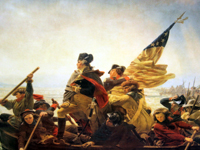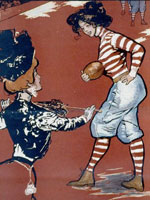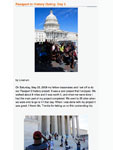Alabama: 5th-Grade Standards
AL.5. Standard: United States Studies—Beginnings to the Industrial Revolution
Fifth-grade content standards focus on the United States from the prehistoric period to the Industrial Revolution.
5.1
-
5.1.1 Students will:
Locate on a map physical features that impacted the exploration and settlement of the Americas, including ocean currents, prevailing winds, large forests, major rivers, and significant mountain ranges (Geography, History).
-
5.1.2 Students will practice:
- Locating on a map states and capitals east of the Mississippi River
- Identifying natural harbors in North America
-
Grade Level Example:
Mobile, Boston, New York, New Orleans, Savannah
5.2
-
5.2.1 Students will:
Identify causes and effects of early migration and settlement of North America.(Geography, History).
5.3
-
5.3.1 Students will:
Distinguish differences among major American Indian cultures in North America according to geographic region, natural resources, community organization, economy, and belief systems (Economics, Geography, History, Civics and Government).
-
5.3.2 Students will practice:
Locating on a map American Indian nations according to geographic region
5.4
-
5.4.1 Students will:
Determine the economic and cultural impact of European exploration during the Age of Discovery upon European society and American Indians (Economics, Geography, History, Civics and Government).
-
5.4.2 Students will practice:
- Identifying significant early European patrons, explorers, and their countries of origin, including early settlements in the New World
-
Grade Level Example:
patrons—King Ferdinand and Queen Isabella
explorers—Christopher Columbus
early settlements—St. Augustine, Quebec, Jamestown - Tracing the development and impact of the Columbian Exchange
5.5
-
5.5.1 Students will:
Explain the early colonization of North America and reasons for settlement in the Northern, Middle, and Southern colonies, including geographic features, landforms, and differences in climate among the colonies (Economics, Geography, History, Civics and Government).
-
5.5.2 Students will practice:
- Recognizing how colonial development was influenced by the desire for religious freedom
-
Grade Level Example:
development in Massachusetts, Connecticut, Rhode Island, Pennsylvania, and Maryland colonies
- Identifying influential leaders in colonial society
- Describing emerging colonial government
-
Grade Level Example:
Mayflower Compact, representative government, town meetings, rule of law
5.6
-
5.6.1. Students will:
Describe colonial economic life and labor systems in the Americas. (Economics, Geography, History).
-
5.5.2 Students will practice:
Recognizing centers of slave trade in the Western Hemisphere and the establishment of the Triangular Trade Route
5.7
-
5.7. Students will:
Determine causes and events leading to the American Revolution, including the French and Indian War, the Stamp Act, the Intolerable Acts, the Boston Massacre, and the Boston Tea Party (Economics, History, Civics and Government).
5.8
-
5.8.1 Students will:
Identify major events of the American Revolution, including the battles of Lexington and Concord, Bunker Hill, Saratoga, and Yorktown (Economics, Geography, History, Civics and Government).
-
5.8.2 Students will practice:
- Describing principles contained in the Declaration of Independence
- Explaining contributions of Thomas Jefferson, Samuel Adams, Paul Revere, Patrick Henry, Thomas Paine, George Washington, Haym Solomon, and supporters from other countries to the American Revolution
- Explaining contributions of ordinary citizens, including African Americans and women, to the American Revolution
- Describing efforts to mobilize support for the American Revolution by the Minutemen, Committees of Correspondence, First Continental Congress, Sons of Liberty, boycotts, and the Second Continental Congress
- Locating on a map major battle sites of the American Revolution, including the battles of Lexington and Concord, Bunker Hill, Saratoga, and Yorktown
- Recognizing reasons for colonial victory in the American Revolution
- Explaining the effect of the Treaty of Paris of 1783 on the development of the United States
5.9
-
5.9.1 Students will:
Explain how inadequacies of the Articles of Confederation led to the creation and eventual ratification of the Constitution of the United States (History, Civics and Government).
-
5.9.2 Students will practice:
- Describing major ideas, concepts, and limitations of the Constitution of the United States, including duties and powers of the three branches of government
- Identifying factions in favor of and opposed to ratification of the Constitution of the United States
-
Grade Level Example:
Federalist and Anti-Federalist factions
- Identifying main principles in the Bill of Rights
- Analyzing the election of George Washington as President of the United States for its impact on the role of president in a republic
5.10
-
5.10.1 Students will:
Describe political, social, and economic events between 1803 and 1860 that led to the expansion of the territory of the United States, including the War of 1812, the Indian Removal Act, the Texas-Mexican War, the Mexican-American War, and the Gold Rush of 1849 (Economics, Geography, History, Civics and Government).
-
5.10.2 Students will practice:
- Analyzing the role of the Louisiana Purchase and explorations of Meriwether Lewis and William Clark for their impact on Westward Expansion
- Explaining the purpose of the Monroe Doctrine
- Identifying Alabama’s role in the expansion movement in the United States, including the Battle of Horseshoe Bend and the Trail of Tears
- Identifying the impact of technological developments on United States’ expansion
-
Grade Level Example:
Steamboat, steam locomotive, telegraph, barbed wire
5.11
-
5.11.1 Students will:
Identify causes of the Civil War, including states’ rights and the issue of slavery (Economics, Geography, History, Civics and Government).
-
5.11.2 Students will practice:
- Describing the importance of the Missouri Compromise, Nat Turner’s insurrection, the Compromise of 1850, the Dred Scott decision, John Brown’s rebellion, and the election of 1860
- Recognizing key Northern and Southern personalities, including Abraham Lincoln, Jefferson Davis, Ulysses S. Grant, Robert E. Lee, Thomas Jonathan ―Stonewall‖ Jackson, William Tecumseh Sherman, and Joseph Wheeler
- Describing social, economic, and political conditions that affected citizens during the Civil War
- Identifying Alabama’s role in the Civil Warn
-
Grade Level Example:
Montgomery as the first capital of the Confederacy, Winston County’s opposition to Alabama’s secession
- Locating on a map sites important to the Civil War
-
Grade Level Example:
Mason-Dixon Line, Fort Sumter, Appomattox, Gettysburg, Confederate states, Union states
- Explaining events that led to the conclusion of the Civil War
5.12
-
5.12.1 Students will:
Summarize successes and failures of the Reconstruction Era (Economics, History, Civics and Government).
-
5.12.2 Students will practice:
- Evaluating the extension of citizenship rights to African Americans included in the Thirteenth, Fourteenth, and Fifteenth Amendments to the Constitution of the United States
- Analyzing the impact of Reconstruction for its effect on education and social institutions in the United States
-
Grade Level Example:
Horace Mann and education reform, Freedmen’s Bureau, establishment of segregated schools, African-American churches
- Explaining the black codes and Jim Crow laws
- Describing post-Civil War land distribution, including tenant farming and sharecropping
5.13
-
5.13.1 Students will:
Describe social and economic influences on United States’ expansion prior to World War I.(Economics, Geography, History).
-
5.13.2 Students will practice:
- Explaining how the development of the transcontinental railroads helped the United States achieve its Manifest Destiny
- Locating on a map states, capitals, and important geographic features west of the Mississippi River
- Identifying major groups and individuals involved with the Westward Expansion, including farmers, ranchers, Jewish merchants, Mormons, and Hispanics
- Analyzing the impact of closing the frontier to American Indians’ way of life
- Explaining how the Spanish-American War led to the emergence of the United States as a world power




 That same year, an after-school group that is co-sponsored by myself and a friend from the National Park Service took a cross-country trip for Lincoln’s Bicentennial. I created another blog for the students to document their adventures and for friends and family back home to be able to find us. What was nice was that because I had been working with the blog in history class, my students were aware of how a blog works and were familiar with how to write for it and their audience. Each student was required to write three times for the blog during the course of our week-long adventure. Each night after our full day they would write on either paper or share the two laptops we brought for blogging. Before going to bed each night I would upload any remaining blog entries. The system proved effective for sharing our adventures and for students documenting their days. The site has also become a great way for Jen Epstein, my National Park Service co-organizer, to share what she is doing in schools for outreach. View it here:
That same year, an after-school group that is co-sponsored by myself and a friend from the National Park Service took a cross-country trip for Lincoln’s Bicentennial. I created another blog for the students to document their adventures and for friends and family back home to be able to find us. What was nice was that because I had been working with the blog in history class, my students were aware of how a blog works and were familiar with how to write for it and their audience. Each student was required to write three times for the blog during the course of our week-long adventure. Each night after our full day they would write on either paper or share the two laptops we brought for blogging. Before going to bed each night I would upload any remaining blog entries. The system proved effective for sharing our adventures and for students documenting their days. The site has also become a great way for Jen Epstein, my National Park Service co-organizer, to share what she is doing in schools for outreach. View it here: 